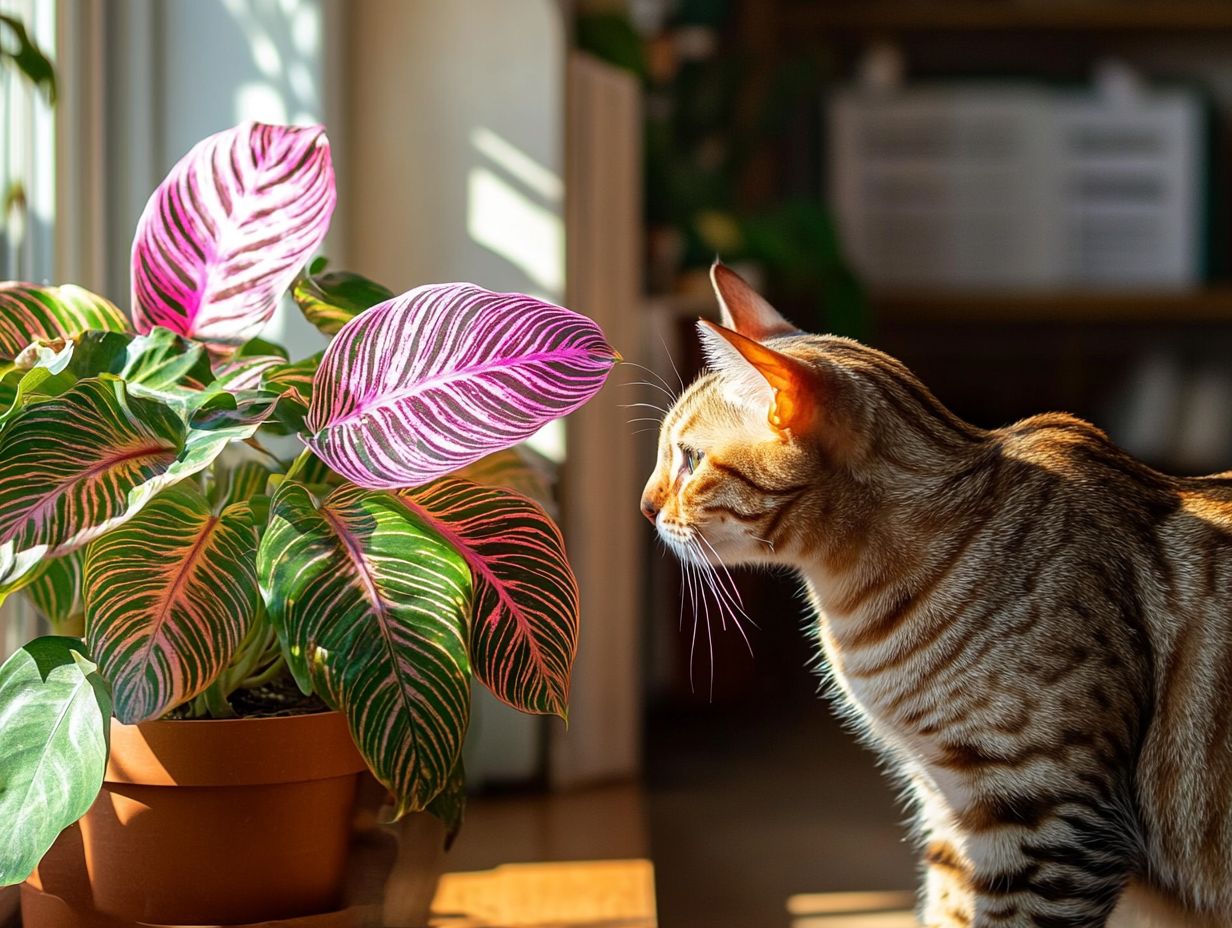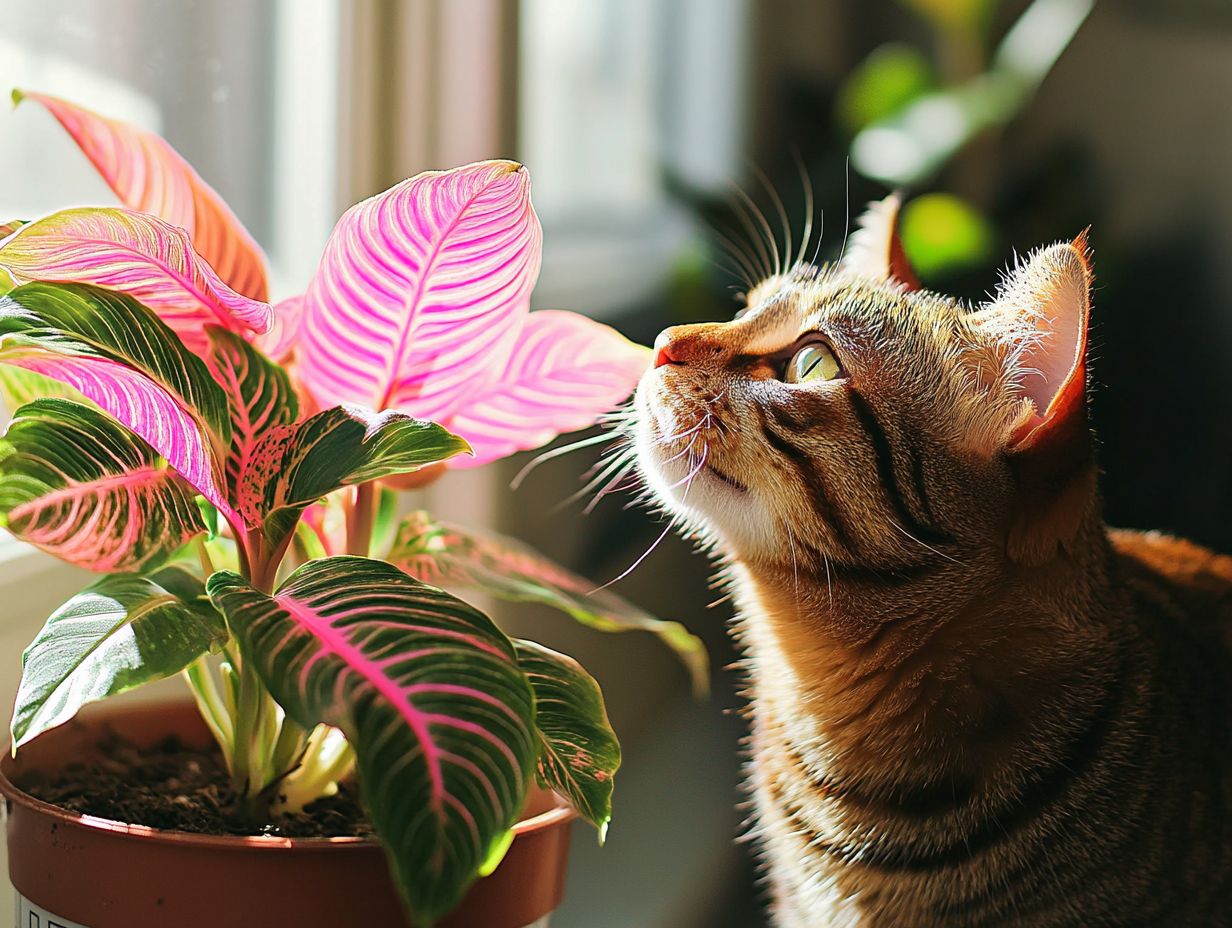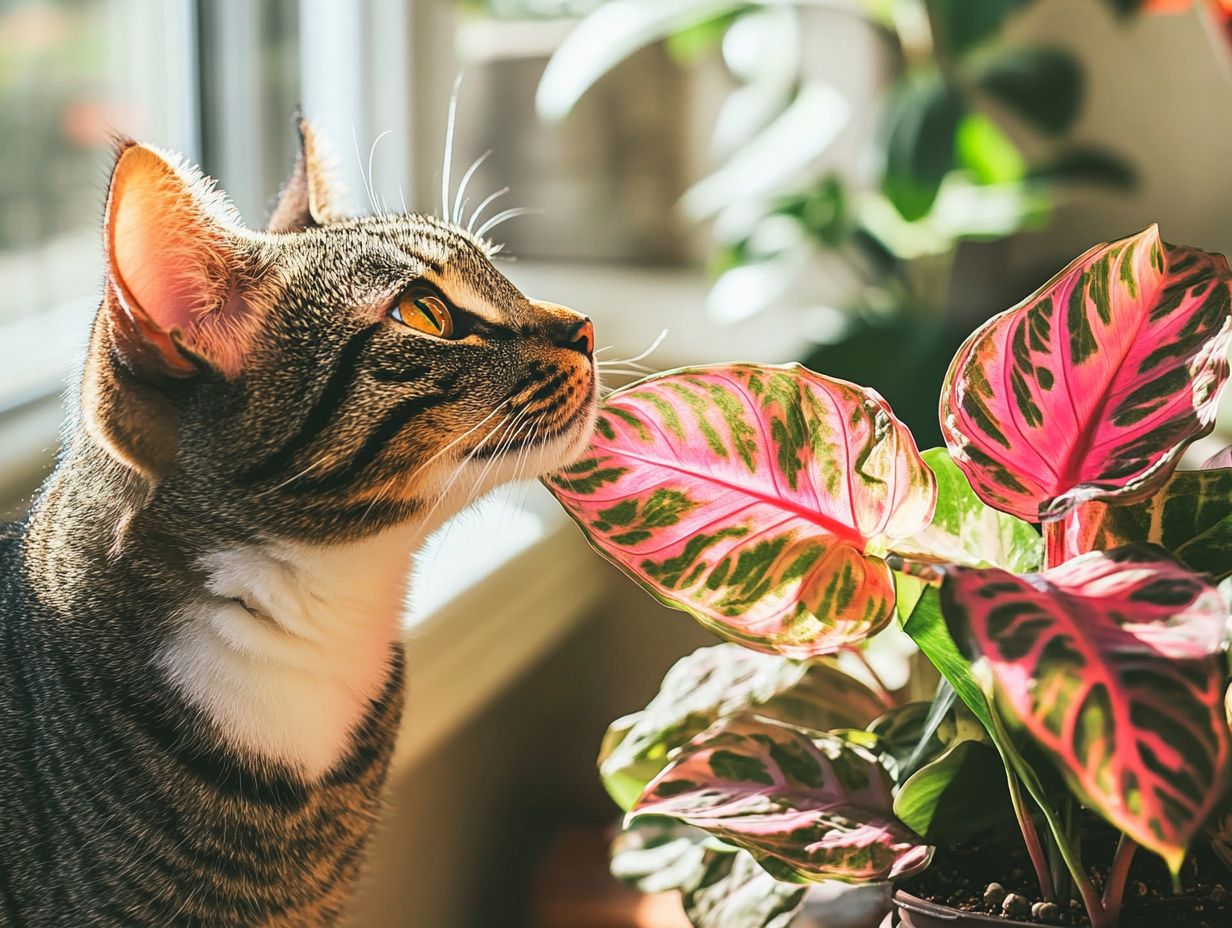Prayer plants are beautiful houseplants known for their stunning foliage and unique leaf movements, and importantly, they are considered non-toxic to cats.
If you’re a cat owner, you might wonder whether these plants are safe for your furry friends.
This article explores what prayer plants are, their potential toxicity to cats, and how to keep your pets safe.
It also provides guidance on recognizing symptoms of poisoning and what steps to take if your cat accidentally ingests a prayer plant.
Read on to ensure a harmonious home for both your plants and pets!
Key Takeaways:

What Are Prayer Plants?
Prayer plants (Maranta leuconeura) are popular indoor plants admired for their vibrant foliage and unique leaf movements that resemble prayer postures, lending a tropical ambiance to any space. As non-toxic houseplants, they not only enhance air quality but also increase humidity, making them ideal for a variety of indoor environments.
Their versatility and aesthetic charm make them a favored choice among both plant enthusiasts and casual decorators. Understanding their care requirements is essential for maintaining the overall health of the plant and fostering an environment where these exotic specimens can thrive.
Are Prayer Plants Safe for Cats?
The prayer plant is a popular choice for indoor gardening due to its broad, colorful leaves. Its scientific name is *Maranta leuconeura*.
According to the ASPCA’s list of safe houseplants, the prayer plant is non-toxic to cats, making it a secure option for cat owners who want to include houseplants in their home.
What Parts of the Prayer Plant Are Toxic to Cats?
While the prayer plant is considered non-toxic, excessive ingestion can lead to mild gastrointestinal upset in some cats. The plant does not contain harmful compounds that cause severe toxicity.
Understanding the visual differences between the prayer plant and other potentially dangerous plants is essential for keeping cats safe. Oval-patterned leaves, similar to those of the prayer plant, can be found in both non-toxic houseplants and those that are harmful.
For instance, dieffenbachia and pothos are known to be more dangerous due to the presence of calcium oxalate crystals, which can cause oral irritation. Other common toxic plants, such as sago palms and certain lilies, can lead to severe reactions if ingested.
Familiarizing oneself with plant identification, including using reliable guides and resources, can significantly help prevent cats from consuming unsafe greenery in their homes.
What Are the Symptoms of Prayer Plant Poisoning in Cats?
Understanding the symptoms of plant poisoning in cats is essential for cat owners who are considering adding decorative indoor plants, such as the prayer plant (Maranta leuconeura), to their home. While the prayer plant is non-toxic, being aware of potential distress symptoms can help ensure your cat’s safety.
Mild symptoms may include slight vomiting or diarrhea, while more severe symptoms that require immediate veterinary attention include lethargy or excessive vomiting. It is crucial to observe your cat’s behavior closely and seek veterinary care promptly whenever these symptoms arise.
Are All Cats at Risk of Prayer Plant Poisoning?

Prayer plants are generally considered non-toxic to cats; however, not all cats will react the same way to plant material they may ingest. Some cats are more curious and prone to nibbling on houseplants, which can lead to gastrointestinal distress.
First Aid and Treatment
If you suspect your cat has ingested a prayer plant, follow these steps:
- Remain calm and observe your cat for symptoms.
- Remove any remaining plant material.
- Contact your veterinarian for advice, providing details about the plant and any symptoms observed.
Prevention and Safety Measures
Consider providing safe alternatives such as cat grass or spider plants to help cat owners make informed choices.
Common Misconceptions
Many people think that all houseplants are harmful to cats; however, some houseplants, like the prayer plant, are safe. It’s important to research individual plants to understand their safety for pets.
Balanced Perspective
It’s essential to maintain a balanced perspective regarding plant toxicity. While the risk of toxicity from prayer plants is low, gastrointestinal upset can still occur, even with non-toxic plants.
Special Considerations
Kittens and senior cats may be more susceptible to gastrointestinal issues from any plant material they ingest, so extra caution is advised.
Call to Action
For emergencies, contact the ASPCA Animal Poison Control at (888) 426-4435.
This article is for informational purposes only and should not replace professional veterinary advice.
Pet owners should be mindful of their cat’s behavior around plants, especially if they have a tendency to chew on foliage, as individual sensitivities can vary widely among felines. Understanding these variations can help owners identify which of their cats may be at greater risk. Cats with a history of gastrointestinal issues and those that are more adventurous may require closer monitoring.
To avoid potential problems, creating a cat-safe environment by removing unsafe plants from their reach is advisable. Additionally, providing suitable alternatives, such as cat grass or interactive toys, can help discourage them from eating houseplants.
How to Keep Cats Safe from Prayer Plants?
Maranta leuconeura is classified as non-toxic to cats. This means that while the plant is safe for your feline friends, it is still important to monitor their behavior, as ingesting any plant can cause gastrointestinal upset in some cats. Pet owners should be aware of any unusual behavior after ingestion, such as vomiting or lethargy.
Creating safe indoor environments for both cats and prayer plants involves strategies that protect the plants while ensuring the pets’ safety and well-being. Since Maranta leuconeura is non-toxic, pet owners can take measures to keep prayer plants out of reach of their cats, thereby ensuring the safety of both.
By observing the cats’ behavioral patterns and establishing boundaries for accessing the plants, it is possible to foster a safe indoor environment while still enjoying the beauty that indoor plants provide.
1. Place Prayer Plants Out of Reach
The simplest way to ensure the safety of both your cats and your prayer plants is to keep the plants out of reach by using elevated surfaces or hanging arrangements. This not only protects your Maranta leuconeura from your pets but also adds an attractive visual element to your home decor by creating interest at different heights.
If you have suitable elevated surfaces or hanging arrangements, it’s best to position your prayer plant where cats cannot reach it. Consider options like high ceilings, wall-mounted plant holders, or hanging macramé planters. Placing the plant near a window can provide the natural light it needs for growth while keeping it out of reach of cats. Additionally, positioning it in an area with indirect sunlight is beneficial.
You can also group it with other houseplants that are safe for cats to create a visually striking arrangement. Just remember to select locations that avoid direct sunlight, as excessive heat can damage the plant.
This approach allows you to keep both your cats and your prayer plant safe while creating an inviting environment in your home that showcases vibrant greenery, surprising and delighting your guests.
2. Use Cat Deterrents
Cat deterrents for plants include sprays, physical barriers, and various other solutions designed to keep cats away from prayer plants. These methods protect Maranta leuconeura from damage while allowing cats to coexist comfortably in the home.
Different types of cat deterrents can be integrated into plant care practices. For instance, using citrus-scented deterrents or placing double-sided tape around the edges of the prayer plant pot can make the plant less appealing to cats.
Additionally, commercial cat repellents and motion-activated ultrasonic deterrents offer the advantage of being safe for cats while effectively helping to preserve the health of the leafy plants.
3. Provide Alternative Safe Plants for Cats
Providing alternative safe plants for cats fosters an environment where both your pets and your prayer plants can coexist peacefully. By incorporating non-toxic plants such as spider plants, Boston ferns, and polka dot plants, you can satisfy your cats’ natural curiosity and chewing habits while safeguarding your Maranta leuconeura. For more information, check out this safety checklist on whether prayer plants are dangerous to cats.
This not only protects your plants but also enhances your indoor gardening experience. Exploring resources and guides for choosing pet-safe plants can be extremely beneficial in making informed decisions.
These resources often highlight plants that are both beautiful and safe for pets, enabling pet parents to create a green space that is enjoyable for all residents. Including varieties like cat grass introduces greenery into your home while offering your cats a healthy and satisfying option to chew on.
Creating a safe environment is essential for the well-being of both the plants and the playful furry friends that share your home. Regularly monitor your plants for any pesticide residues, and ensure that all houseplants are safe, as some may look similar but could be toxic.
What to Do If Your Cat Ingests Prayer Plant?
If you suspect your cat has ingested a prayer plant or any non-toxic plant, keep a close watch for any unusual symptoms such as vomiting or lethargy. While Maranta leuconeura is considered safe, it’s always prudent to consult a veterinarian if you notice any concerning changes in behavior.
In case of ingestion of any plant, follow these first aid steps:
- Stay calm and assess your cat’s condition.
- Check for any immediate symptoms, such as vomiting or diarrhea.
- Contact your veterinarian or an animal poison control hotline for guidance.
- Follow the advice given by the veterinary professional.
It’s always better to err on the side of caution when it comes to your pet’s health.

For any further information on other common houseplants that are safe or toxic for cats, you can explore our related articles for a comprehensive resource for cat owners.
Last reviewed: [Insert Date]
While the prayer plant (Maranta leuconeura) is generally considered non-toxic, it may cause mild gastrointestinal upset in some cats if ingested. It’s crucial to monitor your cat and seek veterinary advice when necessary.
If you suspect that your cat has ingested any part of the prayer plant, take the following steps. Although the plant is non-toxic, you should closely monitor your cat for any unusual behavior. Assess the situation by observing your cat for symptoms such as vomiting or lethargy, and consult your veterinarian for further guidance.
1. Call Your Veterinarian
The first and most important step in addressing the potential ingestion of a prayer plant by your cat is to contact your veterinarian for professional advice. They will provide guidance based on your cat’s individual medical history and any symptoms it may be exhibiting. Clear communication with your vet is crucial to ensuring your cat’s safety and health following a possible ingestion. Consider using resources like PangoVet for additional support.
When you call, it’s helpful to have certain information ready, including your cat’s age, weight, and any observed symptoms, such as vomiting or lethargy. Additionally, the amount of the plant consumed and the time of ingestion are critical details for the vet in determining the appropriate course of action. This contributes to better plant care and pet health management.
Be sure to ask questions about potential side effects, necessary treatments, and any follow-up care that may be required. This preparation helps ensure that the situation is handled appropriately and provides you with peace of mind during what is likely to be a stressful time. Understanding the visual differences among plants can assist in identifying potential threats.
2. Watch for Symptoms
It is important to monitor your cat for symptoms if you suspect it has ingested a prayer plant, even though the plant is considered non-toxic. Symptoms can be categorized as follows:
- Mild Symptoms: Mild gastrointestinal upset may occur, including nausea or slight vomiting.
- Moderate Symptoms: Symptoms such as vomiting, diarrhea, or unusual lethargy may indicate a need for veterinary consultation.
- Severe Symptoms: Severe reactions could include persistent vomiting, shortness of breath, or seizures. If your cat displays these symptoms, seek emergency care immediately.
By closely observing their behavior, you can detect any unusual reactions early, ensuring they receive timely care if needed. Pay attention to any changes in your cat’s appetite and drinking habits, as sudden shifts in these areas could signal a problem.
Additionally, watch for excessive grooming or scratching, which may indicate discomfort. To monitor your cat’s behavior effectively, maintaining a consistent routine and environment will help you quickly notice any deviations from their normal behavior.
Keeping a record of your cat’s eating, playing, and resting habits can also help identify patterns that may be useful to your veterinarian if medical intervention becomes necessary. This practice complements other aspects of indoor gardening and plant safety.
3. Seek Emergency Care if Necessary
Some cats may require emergency care if their symptoms worsen or if there are concerns about their health status after eating a prayer plant. Seeking assistance from a veterinarian or an emergency animal clinic as soon as possible ensures that your cat receives the necessary treatment and care without delay. Prompt action by concerned owners can help minimize the risk of complications and support recovery.
It is important to watch for specific signs that indicate the need for immediate attention, such as persistent vomiting, shortness of breath, extreme lethargy, and significant changes in behavior. If these symptoms are accompanied by seizures or if you notice your cat has pale gums, do not hesitate to seek help, as these may be signs of potentially life-threatening conditions.
Veterinarians are trained to evaluate such situations, using their diagnostic tools to determine the appropriate interventions. Their expertise allows them to quickly assess the severity of symptoms, decide which tests are necessary, and prescribe suitable treatment or stabilization options.
First Aid Steps for Suspected Ingestion
- Stay calm and assess your cat’s condition.
- Contact your veterinarian immediately.
- Have your cat’s details ready: age, weight, symptoms, and amount of plant consumed.
- Do not induce vomiting unless instructed by a veterinarian.
Frequently Asked Questions
Are Prayer Plants Dangerous to Cats and Other Pets?

Yes, prayer plants, such as Maranta leuconeura, can be dangerous to cats. Some varieties contain a compound called insoluble calcium oxalate, which can cause mild gastrointestinal upset when ingested. It’s important for pet safety to keep toxic plants out of reach.
How can I tell if my Prayer Plant is Toxic to Cats?
Common misconceptions exist regarding the toxicity of the prayer plant. While many assume it is highly toxic, it generally causes mild symptoms for most cats. Understanding the plant’s composition and monitoring your cat’s health is essential for allowing a safe coexistence.
Practical Prevention Tips
- Keep plants on high shelves out of your cat’s reach.
- Opt for non-toxic plant alternatives in your home.
- Educate yourself on plant safety and toxicity.
For additional support, refer to resources such as the ASPCA Animal Poison Control for emergency contact information. Remember to consult your veterinarian for medical advice and regularly update your knowledge on plant safety.
Content will be reviewed and updated regularly to reflect the latest research findings. Last reviewed: [Insert Date Here].
Toxicity Categorization: The prayer plant is considered mildly toxic to cats. The toxic parts include the leaves and stems, which contain calcium oxalate crystals.
Check the scientific name of your prayer plant variety. If it contains the word “oxalate” or “oxalate crystals,” it is likely toxic to cats. For accurate plant identification, consult resources like the ASPCA for a list of poisonous plants.
What Are the Symptoms of Plant Poisoning in Cats?
- Mild Symptoms: Drooling
- Moderate Symptoms: Vomiting
- Severe Symptoms: Difficulty breathing, swelling of the tongue and throat
Monitor behavior closely for any health changes. Long-term exposure or ingestion can lead to complications such as chronic gastrointestinal issues.
What Should I Do If My Cat Has Ingested a Toxic Plant?
- Observe your cat for symptoms.
- Contact your veterinarian or a poison control center immediately.
- Do not induce vomiting or give home remedies without professional guidance.
It’s important to have your cat evaluated by a vet, even if symptoms appear mild.
How Can I Ensure Pet Safety Around Prayer Plants?
Make sure to keep all prayer plants out of reach of your cat. Additionally, proper storage of potentially harmful substances is crucial. Consider choosing non-toxic alternatives like spider plants, Kimberly queen ferns, or Boston ferns for your home. Creating a designated safe space for your cat can prevent accidental ingestion and enhance well-being.
What Are Some Safe Houseplants for Cat Owners?
Yes, there are plenty of safe houseplants you can choose from, such as spider plants, African violets, and Boston ferns. Also consider decorative plants like the polka dot plant or ponytail palm. Researching plant safety for pet owners ensures a safe environment.
Special Considerations
Heightened risks are noted for kittens and senior cats due to their fragile health. Always consult a veterinarian for personalized advice.
Additional Resources
- ASPCA Animal Poison Control: [Insert contact number]
For expert input, consult a veterinarian or animal toxicologist regarding plant safety. Always verify with your vet for any medical advice.
Disclaimer: This information is not a substitute for professional veterinary advice. Consult your veterinarian for any health concerns.
Last reviewed: [Insert last review date]. For more information, see our list of other toxic plants.